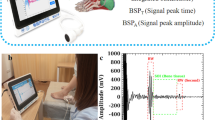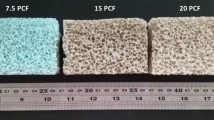Abstract
Purpose
To introduce a new diagnostic parameter: the linear combination of apparent integrated backscatter and spectral centroid shift.
Methods
Ultrasonic backscatter measurements were performed at the calcanei of 1262 volunteers in vivo. The hip and spine bone mineral densities of the volunteers were measured using dual X-ray absorptiometry. The apparent integrated backscatter and spectral centroid shift were calculated. A new diagnostic parameter, i.e., the linear combination of apparent integrated backscatter and spectral centroid shift, was introduced and its correlation to bone mineral density was analyzed.
Results
The results show that the combination of apparent integrated backscatter and spectral centroid shift is significantly correlated to bone mineral density (R = 0.73–0.84, n = 1262, p < 0.05), and that this correlation is more significant than the correlation between the apparent integrated backscatter and bone mineral density or the correlation between spectral centroid shift and bone mineral density (R = 0.48–0.69, p < 0.05).
Conclusion
The combination of apparent integrated backscatter and spectral centroid shift can provide the complementary information of attenuation of the two parameters and predict more information about cancellous bone, and may be employed to assess cancellous bone status.







Similar content being viewed by others
References
Reginster JY, Burlet N. Osteoporosis: a still increasing prevalence. Bone. 2006;38:S4–9.
Jenson F, Padilla F, Bousson V, et al. In vitro ultrasonic characterization of human cancellous femoral bone using transmission and backscatter measurements: relationships to bone mineral density. J Acoust Soc Am. 2006;119:654–63.
Ta D, Wang W, Huang K, et al. Analysis of frequency dependence of ultrasonic backscatter coefficient in cancellous bone. J Acoust Soc Am. 2008;124:4083–90.
Wear KA. Ultrasonic scattering from cancellous bone: a review. IEEE Trans UFFC. 2008;55:1432–41.
Glüer CC, Eastell R, Reid DM, et al. Association of five quantitative ultrasound devices and bone densitometry with osteoporotic spinal fractures in a population-based sample: the OPUS study. J Bone Miner Res. 2004;19:782–93.
Zha XY, Hu Y, Pang XN, et al. Diagnostic value of Osteoporosis Self-Assessment Tool for Asians (OSTA) and quantitative bone ultrasound (QUS) in detecting high-risk populations for osteoporosis among elderly Chinese men. J Bone Miner Meta. 2014;32:1–9.
Wear KA. Estimation of fast and slow wave properties in cancellous bone using Prony’s method and curve fitting. J Acoust Soc Am. 2013;133:2490–501.
Asai H, Kanai H. Noninvasive measurement of stiffness and density of bone for its diagnosis using ultrasound. J Med Ultrason. 2002;29:129–35.
Qin YX, Lin W, Mittra E, et al. Prediction of trabecular bone qualitative properties using scanning quantitative ultrasound. Acta Astronaut. 2013;92:79–88.
Mano I, Horii K, Hagino H, et al. Estimation of in vivo cortical bone thickness using ultrasonic waves. J Med Ultrason. 2015;42:1–8.
Reginster JY, Burlet N. Osteoporosis: a still increasing prevalence. Bone. 2006;38:4–9.
Wear KA, Stuber AP, Reynolds JC. Relationships of ultrasonic backscatter with ultrasonic attenuation, sound speed and bone mineral density in human calcaneus. Ultrasound Med Biol. 2000;26:1311–6.
Litniewski J, Cieslik L, Lewandowski M, et al. Ultrasonic scanner for in vivo measurement of cancellous bone properties from backscattered data. IEEE Trans UFFC. 2012;59:1470–7.
Langton CM, Njeh CF. The measurement of broadband ultrasonic attenuation in cancellous bone-a review of the science and technology. IEEE Trans UFFC. 2008;55:1546–54.
Lee KI. Correlations of linear and nonlinear ultrasound parameters with density and microarchitectural parameters in trabecular bone. J Acoust Soc Am. 2013;134:EL381–6.
Hosokawa A. Finite-difference time-domain analysis of ultrasound backscattering in cancellous bone. Ultrasonics symposium (IUS), 2014 IEEE Int. 2014: 1328–31.
Wear KA, Nagaraja S, Dreher ML, et al. Relationships of quantitative ultrasound parameters with cancellous bone microstructure in human calcaneus in vitro. J Acoust Soc Am. 2012;131:1605–12.
Roux C, Roberjot V, Porcher R, et al. Ultrasonic backscatter and transmission parameters at the os calcis in postmenopausal osteoporosis. J Bone Miner Res. 2001;16:1353–62.
Liu C, Ta D, Hu B, et al. The analysis and compensation of cortical thickness effect on ultrasonic backscatter signals in cancellous bone. J App Phy. 2014;116:124903.
Huang K, Ta D, Wang W, et al. Simplified inverse filter tracking algorithm for estimating the mean trabecular bone spacing. IEEE Trans UFFC. 2008;55:1453–64.
Zhang R, Ta D, Liu C, et al. Feasibility of bone assessment with ultrasonic backscatter signals in neonates. Ultrasound Med Biol. 2013;39:1751–9.
Liu C, Ta D, Fujita F, et al. The relationship between ultrasonic backscatter and trabecular anisotropic microstructure in cancellous bone. J App Phy. 2014;115:064906.
Jiang Y, Liu C, Li R, et al. Analysis of apparent integrated backscatter coefficient and backscattered spectral centroid shift in calcaneus in vivo for the ultrasonic evaluation of osteoporosis. Ultrasound Med Biol. 2014;40:1307–17.
Karjalainen JP, Töyräs J, Riekkinen O, et al. Ultrasound backscatter imaging provides frequency-dependent information on structure, composition and mechanical properties of human trabecular bone. Ultrasound Med Biol. 2009;35:1376–84.
Riekkinen O, Hakulinen MA, Töyräs J, et al. Spatial variation of acoustic properties is related with mechanical properties of trabecular bone. Phy Med Biol. 2007;52:6961.
Wear KA. Characterization of trabecular bone using the backscattered spectral centroid shift. IEEE Trans UFFC. 2003;50:402–7.
Garra BS, Locher M, Felker S, et al. Measurements of ultrasonic backscattered spectral centroid shift from spine in vivo: methodology and preliminary results. Ultrasound Med Biol. 2009;35:165–8.
Pejović-Milić A, Brito JA, Gyorffy J, et al. Ultrasound measurements of overlying soft tissue thickness at four skeletal sites suitable for in vivo X-ray fluorescence. Med Phy. 2002;29:2687–91.
Sabry FF, Ebraheim NA, Mehalik JN, et al. Internal architecture of the calcaneus: implications for calcaneus fractures. Foot Ankle Int. 2000;21:114–8.
Xu K, Ta D, Wang W. Multiridge-based analysis for separating individual modes from multimodal guided wave signals in long bones. IEEE Trans UFFC. 2010;57:2480–90.
Mizuno K, Matsukawa M, Otani T, et al. Propagation of two longitudinal waves in human cancellous bone: an in vitro study. J Acoust Soc Am. 2009;125:3460–6.
Hoffmeister BK, Johnson DP, Janeski JA, et al. Ultrasonic characterization of human cancellous bone in vitro using three different apparent backscatter parameters in the frequency range 0.6–15.0 MHz. IEEE Trans UFFC. 2008;55:1442–52.
Acknowledgments
This study was supported by the NSFC (11174060, 11327405), the Science and Technology Support Program of Shanghai (13441901900), and the Ph.D. Programs Foundation of the Ministry of Education of China (20130071110020).
Author information
Authors and Affiliations
Corresponding author
Ethics declarations
Conflict of interest
The authors declare that there is no conflict of interest.
Ethical statements
All procedures followed were in accordance with the ethical standards of the responsible committee on human experimentation (institutional and national) and with the Helsinki Declaration of 1975, as revised in 2008 (5). Informed consent was obtained from all patients for being included in the study.
About this article
Cite this article
Tang, T., Liu, C., Xu, F. et al. Correlation between the combination of apparent integrated backscatter–spectral centroid shift and bone mineral density. J Med Ultrasonics 43, 167–173 (2016). https://doi.org/10.1007/s10396-015-0690-9
Received:
Accepted:
Published:
Issue Date:
DOI: https://doi.org/10.1007/s10396-015-0690-9




